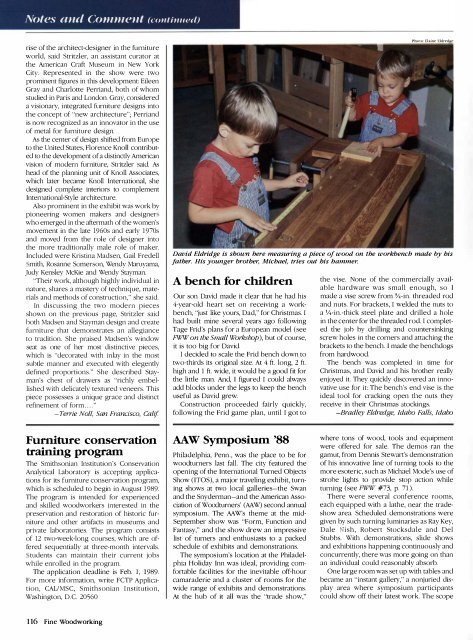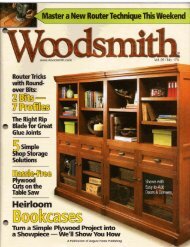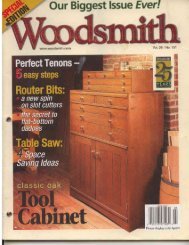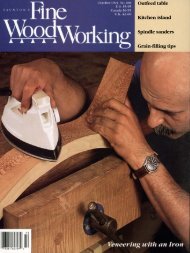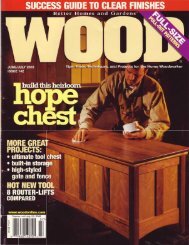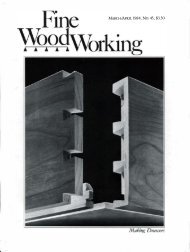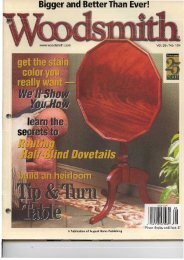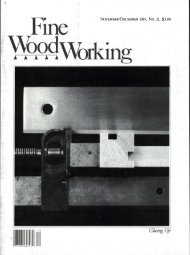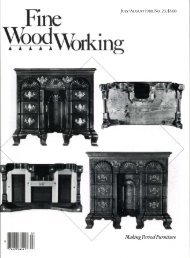Notes and Comment (COUIiIlIll'ti)rise of the architect-designer in the furnitureworld, said Stritzler, an assistant curator atthe American Craft Museum in New YorkCity. Represented in the show were twoprominent figures in tllis development: EileenGray and Charlotte Perriand, botl1 of whomstudied in Paris and London. Gray, considereda visionaty, integrated furniture designs intotile concept of "new architecture"; Perri andis now recognized as an innovator in the useof metal for furniture design.As tile center of design shifted from Europeto tile United States, Florence Knoll contributedto me development of a distinctly Americanvision of modern furniture, SU-itzler said. Ashead of tile planning unit of Knoll Associates,which later becan1e Knoll International, shedesigned complete interiors to complementInternational-Style architecture.Also prominent in the exhibit was work bypioneering women makers and designerwho emerged in tile aftermam of me women'smovement in the late 1960s and early 1970sand moved from the role of designer intome more traditionally male role of maker.Included were Kristina Madsen, Gail Fredellmith, Rosanne S merson, Wendy Maruyama,Judy Kensley McKie and Wendy Stayman."Their work, although highly individual innature, shares a mastety of technique, materialsand methods of construction," she said.In discussing the two modern piecesshown on the previous page, Stritzler saidboth Madsen and Stayman design and createfu rniture that demonstrates an allegianceto tradition. She praised Madsen's windowseat as one of her most distinctive pieces,which is "decorated with inlay in the mostsubtle manner and executed with elegentlydefined proportions." She described Stayman'schest of drawers as "richly embellishedwith delicately textured veneers. Thispiece possesses a unique grace and distinctrefinement of form .... "-Terrie Noll, San Francisco, Calif.Photo: ElaineEldredeDavid Eldridge is shown here measuring a piece of wood on the workbench made by hisfa ther. His younger brother, Michae tries out his hammer.A bench for childrenOur son David made it clear that he had his4-year-old heart set on receiving a workbench,"just like yours, Dad," for Christmas. Ihad built mine several years ago followingTage Frid's plans for a European model (seeFWW on the Small Workshop), but of course,it is too big for David.I decided to scale the Frid bench down totwo-thirds its original size. At 4 ft. long, 2 ft.high and 1 ft. wide, it would be a good fit forthe little man. And, I figured I could alwaysadd blocks under the legs to keep the benchuseful as David grew.Construction proceeded fairly quickly,following the Frid game plan, until I got tothe vise. None of the commercially availablehardware was small enough, so Imade a vise screw from 3/4-in. threaded rodand nuts. For brackets, I welded the nuts toa Ik in.-thick steel plate and drilled a holein the center for the mreaded rod. I completedtlle job by drilling and countersinkingscrew holes in tlle corners and attaching thebrackets to the bench. I made me benchdogsfrom hardwood.The bench was completed in time forChristmas, and David and his brother reallyenj yed it. They quickly discovered an innovativeuse for it: The bench's end vise is theideal tool for cracking open tlle nuts theyreceive in their Christmas tockings.-Bradley Eldredge, Idaho Falls, IdahoF urniture conservationtra ining programThe Smithsonian Institution's ConsetvationAnalytical Laboratoty is accepting applicationsfor its furniture conservation program,which is scheduled to begin in August 1989.The program is intended for experiencedand skilled woodworkers interested in thepreservation and restoration of historic furnitureand otller artifacts in museums andprivate laboratories. The program can istsof 12 two-week-Iong courses, which are offered sequentially at three-month intervals.tudents can maintain their current jobswhile enrolled in the program.The application deadline is Feb. 1, 1989.For more information, write FCTP Application,CAL/MSC, Smithsonian Institution,Washington, D.C. 20560AA W Symposium '88Philadelphia, Penn., was tlle place to be forwoodturners last fall. The City featured theopening of the International Turned ObjectsShow (ITOS), a major traveling exhibit, turningshows at two local galleries-the Swanand the Snyderman-and tlle American Associationof Wooclturners' (MW) second annualsymposium. The MW's theme at the midSeptember show was "Form, Function andFantasy," and tlle show drew an impressivelist of turners and enmusiasts to a packedschedule of exhibits and demonstrations.The symposium's location at the PhiladelphiaHoliday Inn was ideal, providing comfortablefacilities for the inevitable off-hourcamaraderie and a cluster of rooms for thewide range of exhibits and demonstrations.At me hub of it all was the "trade show,"where tons of wood, tools and equipmentwere offered for sale. The demos ran thegamut, from Dennis Stewart's demonstrationof his innovative line of turning tools to themore esoteric, such as Michael Mode's use ofstrobe lights to provide stop action whileturning (see FWW #73, p. 71 ).There were several conference rooms,each equipped with a lathe, near the tradeshowarea. Scheduled demonstrations weregiven by such turning luminaries as Ray Key,Dale ish, Robert StOcksdale and DelStubbs. With demonstrations, slide showsand exhibitions happening continuously andconcurrently, mere was more going on thanan individual could reasonably absorb.One large room was set up with tables andbecame an "instant gallety," a nonjuried displayarea where symposium partiCipantscould show off their latest work. The scope116 Fine Woodworking
MIRRORA· THE HAND MIRRORCOMPLEMENTPERFECTLY BEVELED MIRROR• The finishing touch for all woodcrafters • Ovals. andCircles. In 11 sizes. 3 colors • 1.000.000 pieces instock-UPS Delivery-Ready-to-ship· Any shapeor size can be beveled or fabricated • Glassmirror for all woodcrafting needs-shelves. doors• Any size-thickness up to 1" • Call1-800-MIRRORA NOW to place orders andget our full-line color catalog.tag!/oI .895 Motor ParkwayHauppauge. New York 11788516/234-2200 800-647-7672A BETTER FENCE? PRECISELY!The VEGA SAW FENCE attaches to mostsaws in minutes and features:• SPECIAL ALLOY HEAD which glideson chromed steel rails for rigidity andsmoothness• MICRO-ADJUSTER and MAGNIFYlNGREADER for accurate settings• FINGER SAVER AT TACHMENT withstock pusher and gauging block (option)• REAR HOLD DO WN for use with rollers',·.or feeders .".- '.Route 3, Box 193' . ..; Decatur, Illinois 62526217/963-2232Thoughtfully designed machinnmmJe ;" tlu! USA.Elli33382-1/4 HP Router$2693337 2-114 hp router 2493304 1 hp V.S. plunge router 18917078-1/2" CompoundCrosscutter Saw$4683375 3-1/8" univeral planer 1993380 jointerlspliner 329 7770-10 3.5 hp 10" radial saw 7294024 3 X 21 V.S. belt sander 209(_7790 3.5 hp 12" radial saw 92940900 1 hp router access. kit 139 3590 10" planer/jointer 899e CALL TOll FREEI a 222m. '7 ,a .. >v FOR MIKE OR TOM:TOOL CRIB OF THE NORTH SINCE 1948P.O. Box 1716, Grand Forks, ND 58206 1 -800-358-3096.Back Issue SlipcasesBound in dark blue and embossed in gold, each case holds atleast six issues of Fine Woodworking (a year's worth), and costs$7.95 ($21.95 for 3, $39.95 for 6). Add $1.00 per case forpostage and handling. Outside the U.S., add $2.50 per case (U.S.funds only). PA residents add 6% sales tax.Send your order and payment to:Jesse Jones IndustriesDept. FW, 499 E. Erie AvenuePhiladelphia, PA 191341-800-972-58582 5"Heavy Duty ConstructionCombination Heads37" Model - 20 Hp • 25" Model - 15 HpVariable speed conveyers&37"Wide BeltSanderHeavy Duty ShaperReversible 2-speedYo" spindle("-1"-1Y." spindle available)Shipping Wt-53 IbsWE'll BEAT ANYONE'S PRICE! CAll NOW.§imiJY§YJhg§Q9t@im9hiMN.. ( 1·q·:Jaql.WWFpl. .• .fi9IriWt*cfMAlltech U.S.A.P.O. Box 65,U.S.TOllN.C.Tyner, N.C. 27980FREE--1-800-426-2732Acme ElectricAdams Wood ProductsAddkison HardwareAdjustable Clamp CompanyAdvanced Machinery ImportsAlltech, U.s.A.Amazon LumberAmerican ClampAmerican WoodcraftersAndreou IndustriesAshman TechnicalAviationlIndustriai SupplyBall & BallBartley CollectionBenny's WoodworksBerea HardwoodsBlack & DeckerBoulter PlywoodBrandMarkBridge City Tool WorksByrom Inti.Calculated IndustriesCane & BasketCascade Precision ToolClassifiedClayton EnterprisesCollege of the RedwoodsCompu-CompassMaurice 1. CondonConstantineCraft Supplies USADelmhorst InstrumentDeltaDollar Trading Co.Ebac Lumber DryersEcon-AbrasivesEverlast SawExact CutsExcalibur Machine & ToolF. S. ToolFarris MachineryFisher Hill ProduqsFloral Glass & MirrorFoley-Belsaw Co.Forrest ManufacturingFreudFrog Tool Co. Ltd.Furniture DesignsG.M.S. DistributingGarrett WadeINDEX TO ADVERTISERS104, 117 Gilliom Mfg. 1824 Grizzly Imports 7.88,11330 Hardwood Design Tools 5115 Hardwoods of Illinois 9226 Harper Hardware 22117 Hartwood 9232 Hida Japanese TooLs 18III Highland Hardware 1327 Home Lumber 8826.90 Horton Brasses 91HTC Products 319 Hubbard Harpsichords25 Imported European Hardware 526 Incra Jig 9092 J. Philip Humfrey 3288 JDL 182 Jesse Jones Ind. 11724 K&S SpeCialty Lumber 2792 Bob Kaune 309 Keen Edge9327RBI IndustriesReliable GrindingRITRobert LarsonRobert Sorby Ltd.ROCkingham Comm. cou.Rudolf Bass, Inc.RyobiSanta Rosa ToolThe SawmillSeven CornersShaker WorkshopsShophelperSilverton Victorian MillworksSingley SpecialtySisco SupplyThe SourceSquare Drive ScrewSteve H. Wall Lumber18Sunhill 20,11924,88,99 Knecht Home Center 31 Symtec America 1923Kodansha IntI. II Systi-Matic 9634 Kuster Mfg. 30 Tarheel Filing Co. 9229 Laguna Tools 9 The Taunton Press 33. 103100·102 Robert Larson 96 Toolhauz91 Leeds Design Workshops II Toolmax 5II Leigh Industries 13 Tools Etc. 2527 LeNeave Supply 20 Total Shop 995 Lignomat USA 24 Transpower 10122 Lobo Power Tools 34 Uniquest Corp. 17115 Manny's Woodworker's PlaceVega 117909491 Manufacturers Service 24 Waverly Woodworks 591 Mason & Sullivan 91 Whole Earth Access 9593 McFeely Hardwoods 89 Wilke Machinery 8722 Mini Max 86 Williams & Hussey 2622 MLCS 23.94,98 Williams Tool III13 Northland Woodworking Supply 91 Wood-Mizer 9122 Northwood Industrial Machines 30 Wood World 3413 Nova Tool 22 Woodcraft 8696 Onsrud 32 Woodenboat 893499 Paxton HardwareWoodfinisher Industries 1925 Penn State Industries 31 Woodmaster Tools 19. III117 Perfonnax Products 90 Woodshop SpeCialties32 Philipps Bros. Supply 98 Woodworkers' Store 3217 Pootatuck 89 Woodworker's Supply 3497 Porta-Nails 7,86 The Woodworking Shows 1722 Porter Cable 15 Woodworking World Shows 522 Powermatic 28 Worcester Craft Center 2722 Pro Tools 115 Workbench Tool 9.9221 Projects In Metal II Xylophile's 892799II96241979351835349227183298999394January/February 1989 117
- Page 3 and 4:
FineW> rktng'_' ______ ___ January/
- Page 6 and 7:
Letters (contillued)never hurt hims
- Page 8 and 9:
MetiJods of Wo rkedited and drawn b
- Page 10 and 11:
Methods of Wo rk (contillued)exampl
- Page 12 and 13:
Making a door sandwichI intend to m
- Page 14 and 15:
Q & A (colltillued)of a bad situati
- Page 16 and 17:
Pollou'-upby Dick BurrowsMore on to
- Page 18 and 19:
Easy toStep by Step DrawingsBuildOn
- Page 20 and 21:
(25 years)P-SOO20" PlANERSEATTLE:1
- Page 22 and 23:
There areover 4,000money-savingreas
- Page 24 and 25:
READY TO ASSEMBLE-SOLID-CHERRYWALNU
- Page 26 and 27:
THE BARTLEYBUNDLES!AlJ.500 ·24"Ban
- Page 28 and 29:
A GREAT DEA.L IMORE (f)5 HP, 3 Ph3
- Page 30 and 31:
--ANTIQUE & USED TOOLSQuality, olde
- Page 32 and 33:
PhoneStater--- - -[][]Ur:iTheWoodwo
- Page 34 and 35:
"""""',' Universal Precision Measu
- Page 36 and 37:
FineWorking January/February 1989M
- Page 38 and 39:
Once the backrest plaques are joine
- Page 41 and 42:
Fig. 4:.1:iim.lf1lmllli.iiiiie?tII
- Page 43 and 44:
Secret compartments were so common
- Page 45 and 46:
-----.JFig. 4: Hanging tray below t
- Page 47 and 48:
Tbree examples of the author's slid
- Page 49 and 50:
worked but will maintain a crisp, s
- Page 53 and 54:
SCROLL-SA W TESTCompany and model L
- Page 55 and 56:
An ordinary woodturning lathe can b
- Page 57 and 58:
use a dust collector, and if possib
- Page 59 and 60:
I've never been especially fond of
- Page 61 and 62:
and it shields your fingers from ex
- Page 63 and 64:
The cabinet scraper used by the aut
- Page 65 and 66: Fig. 2: Post:Modern Table Top, 52 i
- Page 67 and 68: Fig. 3: LFI TableNut is fastened to
- Page 69 and 70: Fig. 3: Curved miterPattern doesn't
- Page 71 and 72: Selections from the author's sketch
- Page 73 and 74: thor anticipate problems and make f
- Page 75 and 76: Fig. 2: Air flowMoist air exits thr
- Page 77 and 78: lating fan. The idea here is to ins
- Page 79 and 80: Long prized by woodworkers for its
- Page 81 and 82: A Chinese woodworker assembles an e
- Page 83 and 84: Chinese shaping toolsThroughout Chi
- Page 85 and 86: Using a Holtzapffel ornamental lath
- Page 87 and 88: NOW! BUY BRIDGEWOOD IN CANADA . ..
- Page 89: QiUl j!! IIIc:Ul.=:c ...!!
- Page 92 and 93: 111,"11SIOPm'EI.I,lu it ....IS •
- Page 94 and 95: CARBIDE TIPPED ROUTER BITSPRCAL PRO
- Page 96: FS Tool CorporationP.o. Box 510, 21
- Page 99 and 100: ... !Ij*;::""' eMore NTS 14-5614" H
- Page 101 and 102: FI:\ISHI:\G SLPPLIESIf you have bee
- Page 103 and 104: T\UNTONPUBliCATIONS... by fellow en
- Page 105 and 106: PmeWqqQWorkingIndex to issues 66 th
- Page 107 and 108: FowlerFowler, Brian, chair by, 67,1
- Page 109 and 110: ScrewsZimmerScrews:brace driving of
- Page 111 and 112: 34-76 1 10' Uni s-l-l/2 hp ........
- Page 113 and 114: MOISTURE METERFAMOUS "MINI-LiGNO"MA
- Page 115: Dependable extra hands for all type
- Page 119 and 120: £'Delrl.lnc'e To Manufacture Quali


